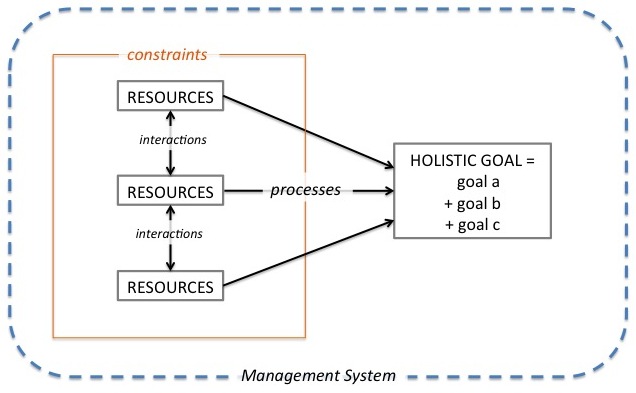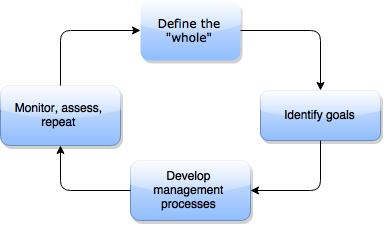Decision Making Framework:
As the water chain assessment has revealed, Surrey’s water system is complex, highly integrated, and requires a new style of management in order to ensure that it can continue to function in the face of increased demands and threats to water quality. Water is a unique and highly interconnected resource; therefore as water resources become vulnerable, there is a need to move away from single-priority management systems and begin to consider the resource on a broader, system-based scale. The principles of holistic management can provide a useful framework for developing such a management system, on a scale from an individual farm to the overall Surrey region.
Holistic management is a paradigm of decision-making that prioritizes systems-based thinking. It recognizes interconnectedness, and emphasizes that there are no isolated systems or boundaries – rather, there are only collections of “wholes within wholes.” [1] As a result, unlike traditional resource management systems that focus on managing individual components towards specific goals, holistic management focuses on managing the interactions between system components in order to achieve one holistic goal made up of many parts.
Figure 1: In traditional resource management, each resource is managed individually, for the purpose of achieving a specific goal. Consideration of interactions between resources, and the achievement of the other goals is generally outside the scope of the management plans.
Figure 2: In holistic resource management, resources are considered as a network of interacting parts, and are managed as a whole in order to achieve one holistic goal. Holistic goals are usually made up of many parts; however by integrating them into one goal, the individual goals are given equal consideration.

Holistic management is a useful framework to guide the regional scale management of Surrey’s water system; however it can also be used on a micro-scale at the individual farm level. Because farms are basically the management of resources to produce certain goals, the principles of holistic management can be used to develop resource-efficient farming systems. This framework can also be customized according to the unique priorities and characteristics of different systems – this framework is based on the unique characteristics of Surrey, therefore it will prioritize increasing resource-efficient, small-scale agricultural productivity in a peri-urban environment. At both the macro and micro scale, the decision-making framework follows the following steps:

- Define the “whole:” The first stage is determining the scope of the system that is going to be managed. Holistic management is founded on the principle that everything is connected; however, it is necessary to define a boundary in order for management to be feasible. In the case of the Surrey water system, boundaries may be set at variety of options: at the municipal boundary, at the community level, or according to watershed extents, to name a few. Once the boundary is determined, an inventory of the system components should be created. Components include all resources, decision-maker, users, ecosystem processes, and capital available within the system. The inventory should also include an assessment of any constraints that may limit the use of these resources. The water chain and suitability assessments are examples of how Surrey’s water resources have been evaluated for constraints. In Surrey, the other resources that should be evaluated at the farm scale include: soil, topography, plot size, market demand, and labour. Evaluating constraints are an important way to understand the capability of the overall system, and will aid with creating feasible goals.
- Identify the goals for the system. Once a system is defined and the productive capacity of its resources is understood, it is possible to establish goals for the system. The individual goals created will be united as a holistic goal, in which achievement of all the goals are considered equally in and conjunction with each other, over the span of the immediate and long-term future. Holistic goals should be adaptable and flexible as to how they are achieved, yet specific about the desired functioning of the system. [2] In Surrey’s water system, the existing goals include agricultural production, provision of aquatic habitat, recreation, and flood protection; however under a holistic goal, there may also include factors concerning the long-term well being of Surrey citizens.
- Develop processes to meet the goals. As is demonstrated in figure 2, processes are the critical links that direct resources towards achieving goals. In this way, processes are a resource manager’s tools: they should aim to protect, improve, or create the processes that maximize the productivity of resources or ease the constraints on them; or remediate or eliminate the processes that diminish the system’s ability to meet its goal. Processes can be defined as any action that alters the location, quality, or quantity (and thus productivity) of resources. They may be the result of natural occurrences, such water infiltration or evapotranspiration; or they may be the result of human-created conditions, for example through cropping-irrigation-soil management combinations.
- Monitor, assess, and repeat. Because holistic management involves complex, multi-dimensional goals that span both short and long-term time spans, it is critical that the overall management process be continuous and iterative. The holistic goals focus the direction that the system moves in; however it does not govern the processes that are used to get it there. This is because the most appropriate processes are contingent upon the context of the system, and contexts can change over time. As a result, it is critical that holistic management programs involve continuous monitoring, assessments of success, and adaptation of processes.

